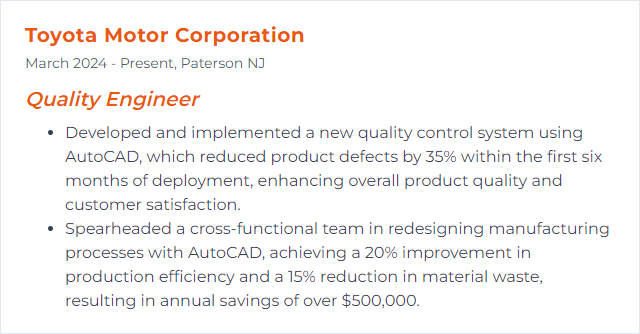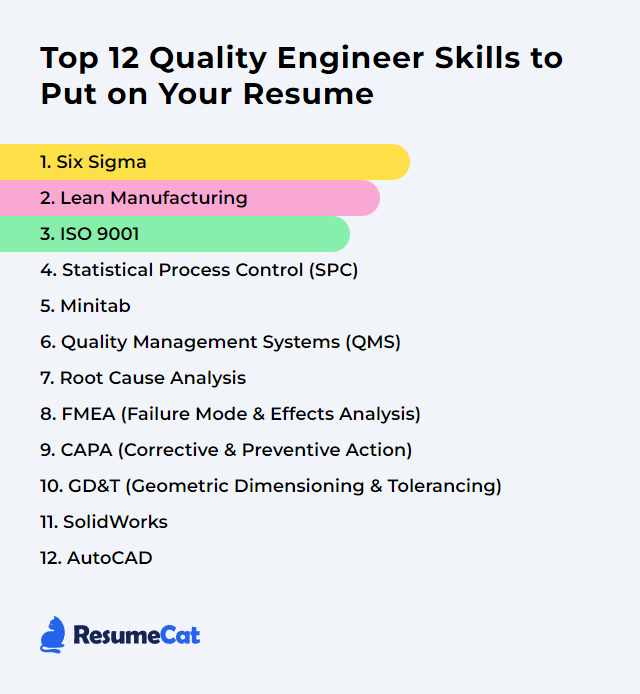Top 12 Quality Engineer Skills to Put on Your Resume
The market is noisy, fast, and unforgiving. A quality engineer’s resume has to punch through that noise. Blend sharp technical depth with people-savvy execution, and your skills don’t just sit on the page—they signal trust, rigor, and outcomes.
Quality Engineer Skills
- Six Sigma
- Lean Manufacturing
- ISO 9001
- Statistical Process Control (SPC)
- Minitab
- Quality Management Systems (QMS)
- Root Cause Analysis
- FMEA (Failure Mode and Effects Analysis)
- CAPA (Corrective and Preventive Action)
- GD&T (Geometric Dimensioning and Tolerancing)
- SolidWorks
- AutoCAD
1. Six Sigma
Six Sigma is a disciplined, data-first approach to improving processes. It hunts defects, squeezes out variation, and builds repeatable results across manufacturing and business workflows.
Why It's Important
It gives a quality engineer structure and teeth—DMAIC roadmaps, hard numbers, and a shared language—to reduce waste, boost yield, and lift customer satisfaction while cutting cost.
How to Improve Six Sigma Skills
Sharpening Six Sigma isn’t a one-and-done exercise. Make it habitual and visible:
Deepen statistics fluency: hypothesis tests, capability, regression, DOE. Know when each tool earns its keep.
Blend Lean with DMAIC: remove waste before optimizing; faster wins, cleaner data, smoother projects.
Advance your belt level: run projects end-to-end, mentor others, and document sustained results.
Run tight projects: charters, stakeholder buy-in, risk logs, clear gates. No loose edges.
Strengthen soft skills: crisp storytelling, active listening, conflict navigation—projects rise or fall on alignment.
Tool up: SPC software, statistical packages, and visual dashboards that surface signal quickly.
Benchmark and iterate: compare against peers, borrow good ideas, retire stale habits.
Stay current: emerging analytics, automation, and industry expectations shift fast—keep pace.
How to Display Six Sigma Skills on Your Resume
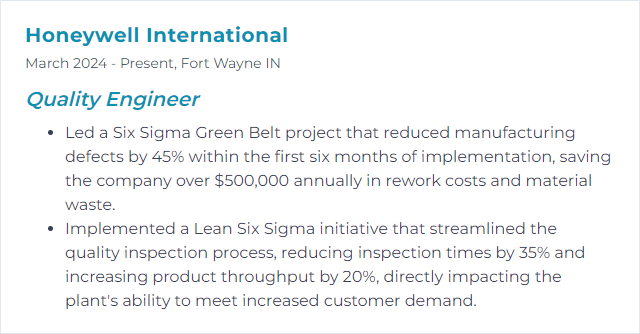
2. Lean Manufacturing
Lean Manufacturing streamlines flow by eliminating waste and amplifying value. It’s about clarity of process, fast feedback, and steady momentum.
Why It's Important
For a quality engineer, Lean trims defects at the source, shortens cycle times, and stabilizes processes, which makes every other quality tool more effective.
How to Improve Lean Manufacturing Skills
Go practical and specific:
Spot the eight wastes: defects, overproduction, waiting, non‑utilized talent, transportation, inventory, motion, and extra processing. Make them visible; then remove them.
Run 5S: sort, set in order, shine, standardize, sustain. Clean workspaces reveal hidden problems.
Standardize: robust SOPs, visual work, and layered audits to keep drift in check.
Improve continuously: Kaizen events and daily problem-solving beats big-bang fixes.
Quality at the source: design error-proofing (poka‑yoke), add-andon style signals, and stop-to-fix behaviors.
Right-size flow: pull systems, kanban, and leveled scheduling to balance demand and capacity.
Decide with data: SPC, takt tracking, and value stream maps that expose bottlenecks and rework loops.
Align suppliers: shared standards, incoming quality checks, and joint improvement plans.
How to Display Lean Manufacturing Skills on Your Resume
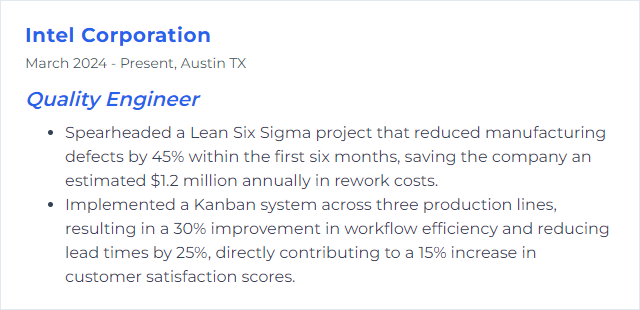
3. ISO 9001
ISO 9001 sets the framework for a quality management system that consistently meets requirements and elevates customer trust. It emphasizes process approach, risk-based thinking, and continual improvement.
Why It's Important
It anchors quality work to a repeatable system—clear roles, controlled documents, robust audits, and management reviews—so results don’t depend on heroics.
How to Improve ISO 9001 Skills
Make the system breathe, not just pass audits:
Know the clauses deeply: context, leadership, planning, support, operation, performance evaluation, improvement.
Engage leadership: quality objectives tied to strategy, resources aligned, barriers removed.
Train broadly: everyone understands their piece of the QMS and how it affects the customer.
Use the process approach: define inputs/outputs, owners, risks, measures, and interactions across the value chain.
Manage risk and opportunities: integrate risk thinking into change control, design, and supplier management.
Audit for insight: internal audits that find causes, not just check boxes; use ISO 19011 guidance as a model.
Review and act: management reviews that drive decisions, not slides; close on actions with dates and owners.
Close the loop: corrective action that fixes systems, confirms effectiveness, and shares lessons learned.
How to Display ISO 9001 Skills on Your Resume
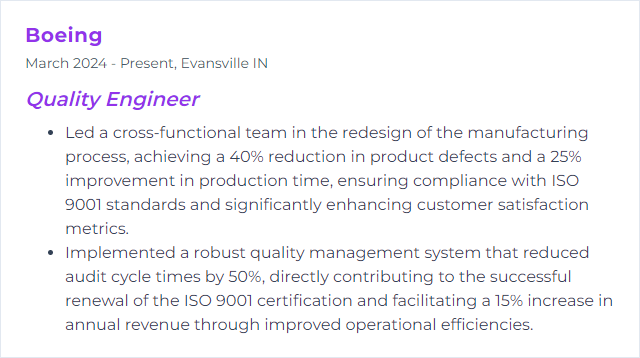
4. Statistical Process Control (SPC)
SPC uses statistics to monitor and control processes, separating common-cause noise from real shifts so you act only when it matters.
Why It's Important
It protects quality in real time, reduces scrap and rework, and exposes instability before customers ever see it.
How to Improve Statistical Process Control (SPC) Skills
Dial in measurement, then manage variation:
Validate measurement systems: MSA for accuracy, precision, linearity, stability, and bias.
Choose the right charts: X‑bar/R, X‑bar/S, I‑MR, p/np, c/u—match chart to data type and sampling plan.
Use rational subgrouping: sample design that isolates short-term variation from long-term drift.
Act on signals: when rules trigger, pause and investigate immediately; avoid tampering.
Tie to capability: Cp, Cpk, Pp, Ppk for voice-of-process vs. voice-of-customer alignment.
Automate where sensible: real-time dashboards and alerts that surface out-of-control conditions fast.
Coach the floor: teach operators what the charts mean and how to respond.
How to Display Statistical Process Control (SPC) Skills on Your Resume
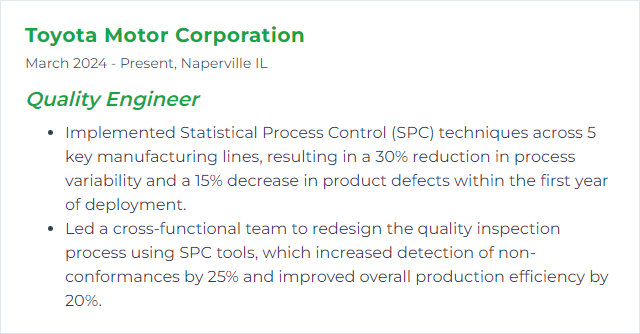
5. Minitab
Minitab is a statistical workbench built for quality improvement—control charts, capability, DOE, reliability, and more—wrapped in a workflow that speeds analysis.
Why It's Important
It turns raw data into decisions. Faster diagnostics, clearer visuals, fewer guesses.
How to Improve Minitab Skills
Practice with purpose:
Master foundations: data types, graphs, descriptive stats, and clean imports.
Lean into quality tools: SPC, capability, gage R&R, Pareto, and control plan tie-ins.
Run DOE: screening, full/frac factorials, response surface—optimize with confidence.
Build repeatability: macros and templates that standardize analyses across teams.
Tell the story: annotate output, use confidence intervals, and connect results to actions.
Stay updated: explore new features and keep your toolset current with your projects.
How to Display Minitab Skills on Your Resume
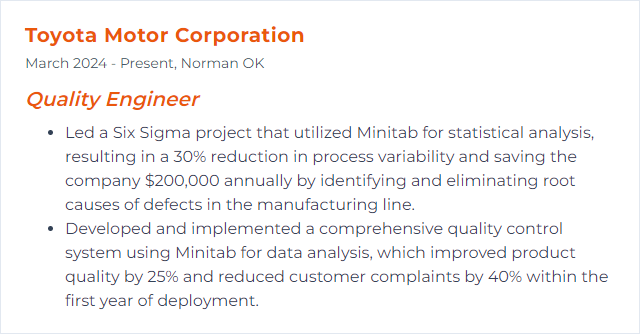
6. Quality Management Systems (QMS)
A QMS documents how quality happens—processes, responsibilities, controls, and measures—so good outcomes become consistent outcomes.
Why It's Important
It aligns people, process, and data. Less firefighting, more foresight.
How to Improve Quality Management Systems (QMS) Skills
Make the system usable and auditable:
Audit with intent: frequent, focused audits that drive corrective and preventive action.
Train and engage: role-based training, simple procedures, and visible metrics.
Optimize processes: lean out waste, mistake-proof critical steps, tighten change control.
Listen to customers: feed complaints, returns, and NPS into improvement pipelines.
Track KPIs: scrap, FPY, on-time delivery, complaint rates—review and respond.
Stay compliant: current standards, regulatory shifts, and supplier alignment built into the system.
Digitize wisely: document control, CAPA, training, and audit management in one place for traceability.
How to Display Quality Management Systems (QMS) Skills on Your Resume
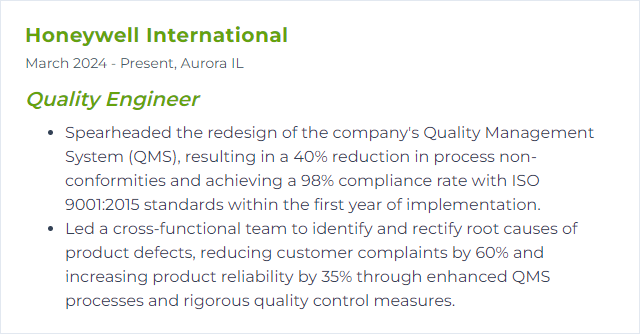
7. Root Cause Analysis
Root Cause Analysis digs past symptoms to the systemic cause, then fixes the system so the problem can’t easily return.
Why It's Important
Quality improves for good—less recurrence, fewer band-aid fixes, stronger processes.
How to Improve Root Cause Analysis Skills
Be methodical, not theatrical:
Frame the problem: tight problem statements, time-bounded, with clear impact and evidence.
Use structured tools: 5 Whys, fishbone, fault tree, Pareto, and process maps—triangulate causes.
Collect real data: verify with gemba observation, layered checks, and clean measurements.
Test fixes: PDCA or small pilots before broad rollout.
Verify effectiveness: SPC trends, before/after capability, and audit checks.
Document and share: capture the story, standardize the lesson, prevent echoes elsewhere.
How to Display Root Cause Analysis Skills on Your Resume

8. FMEA (Failure Mode and Effects Analysis)
FMEA systematically identifies how things might fail, why they would fail, and what that failure would do—then prioritizes actions to reduce risk.
Why It's Important
It prevents problems before they ship, improves safety and reliability, and guides design and process choices with risk front and center.
How to Improve FMEA (Failure Mode and Effects Analysis) Skills
Modernize and tighten the practice:
Define scope: clear boundaries and assumptions for the product or process.
Build a cross‑functional team: design, manufacturing, service, and suppliers where relevant.
Use current guidance: apply AIAG‑VDA approaches and Action Priority (AP) over simple RPN where appropriate.
Ground in data: field returns, test results, SPC, and voice-of-customer to size occurrence and detection.
Drive actions: specific owners, due dates, and verifiable risk reduction; close the loop.
Keep it living: update after design changes, process shifts, or new failure evidence.
Support with tools: structured templates or software for traceability and consistency.
Teach the method: align teams on rating scales, terminology, and decision rules to avoid noise.
How to Display FMEA (Failure Mode and Effects Analysis) Skills on Your Resume
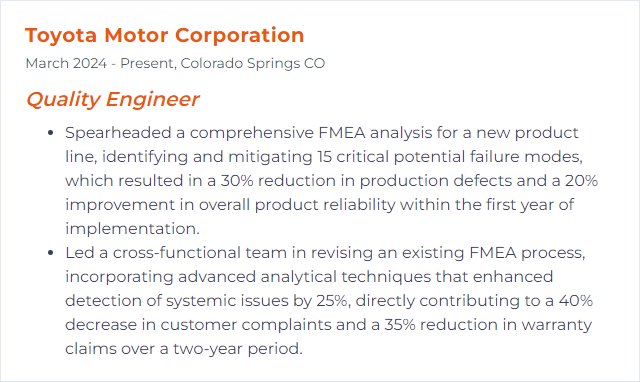
9. CAPA (Corrective and Preventive Action)
CAPA is the backbone of systemic fix and prevention—correct the issue, eliminate the cause, and verify it stays fixed.
Why It's Important
It turns incidents into improvements and keeps compliance clean—evidence, traceability, and effectiveness checks included.
How to Improve CAPA (Corrective and Preventive Action) Skills
Make CAPA sharper and faster:
Define precisely: clear problem statements with scope, impact, and containment.
Find true causes: combine RCA tools and data to avoid symptom-chasing.
Plan actions that matter: specific, measurable, time-bound, risk-based, and proportionate to impact.
Implement with control: project plans, change control, training, and communication rolled together.
Verify effectiveness: objective evidence through trend data, audits, and on-the-floor checks.
Document thoroughly: trace from issue to closure, with lessons learned fed back into the system.
Digital tracking: centralized CAPA logs and dashboards to prevent drift and missed due dates.
How to Display CAPA (Corrective and Preventive Action) Skills on Your Resume

10. GD&T (Geometric Dimensioning and Tolerancing)
GD&T communicates the intended geometry and allowable variation using standardized symbols. Parts fit, function, and interchange because ambiguity is gone.
Why It's Important
It bridges design, manufacturing, and inspection. Better tolerancing means fewer surprises and less cost to achieve precision.
How to Improve GD&T (Geometric Dimensioning and Tolerancing) Skills
Mix study with repetition:
Learn the standard: ASME Y14.5 (current edition) terminology, symbols, and rules.
Practice on real prints: apply datums, feature control frames, and material modifiers correctly.
Close the loop with metrology: CMM strategies, functional gauges, and measurement uncertainty awareness.
Design for inspection: tolerance schemes that can be verified reliably and quickly.
Get feedback: reviews with design, manufacturing, and quality to find misunderstandings early.
Use CAD validation: leverage model-based definition and CAD tools that enforce standards.
How to Display GD&T (Geometric Dimensioning and Tolerancing) Skills on Your Resume

11. SolidWorks
SolidWorks enables precise 3D design, simulation, and documentation—vital for verifying fit, function, and manufacturability before metal meets machine.
Why It's Important
It catches problems early, aligns teams on a single source of truth, and speeds design-to-production handoffs.
How to Improve SolidWorks Skills
Get faster and more accurate:
Nail the essentials: sketching discipline, robust features, clean assemblies, and configurations.
Use advanced tools: tolerance analysis, GD&T integration, interference checks, and large assembly strategies.
Simulate early: structural, modal, thermal, and motion checks to de-risk designs.
Standardize: templates, title blocks, design libraries, and naming conventions for consistency.
Customize the workspace: shortcuts, macros, design tables—turn clicks into seconds saved.
Collaborate: eDrawings, PDM, and 3D model markup for quick review cycles.
How to Display SolidWorks Skills on Your Resume

12. AutoCAD
AutoCAD produces precise 2D and 3D drawings that define features, tolerances, and processes with clarity—essential for reliable manufacturing and inspection.
Why It's Important
Good drawings reduce ambiguity and rework, keep revisions under control, and accelerate approvals.
How to Improve AutoCAD Skills
Precision first, speed second—then both:
Master core commands: layers, blocks, snaps, constraints, and annotation done right.
Customize: tool palettes, profiles, and keyboard shortcuts tuned to your workflows.
Template everything: title blocks, dim styles, plot settings, and standards that stick.
Go advanced: dynamic blocks, sheet sets, external references, and parametric constraints.
Automate: scripts and LISP for repetitive tasks; reduce error and tedium.
Control revisions: disciplined versioning, cloud markups, and redline-to-release flow.
Practice with real work: drawings that tie directly to inspection and process planning.
How to Display AutoCAD Skills on Your Resume
